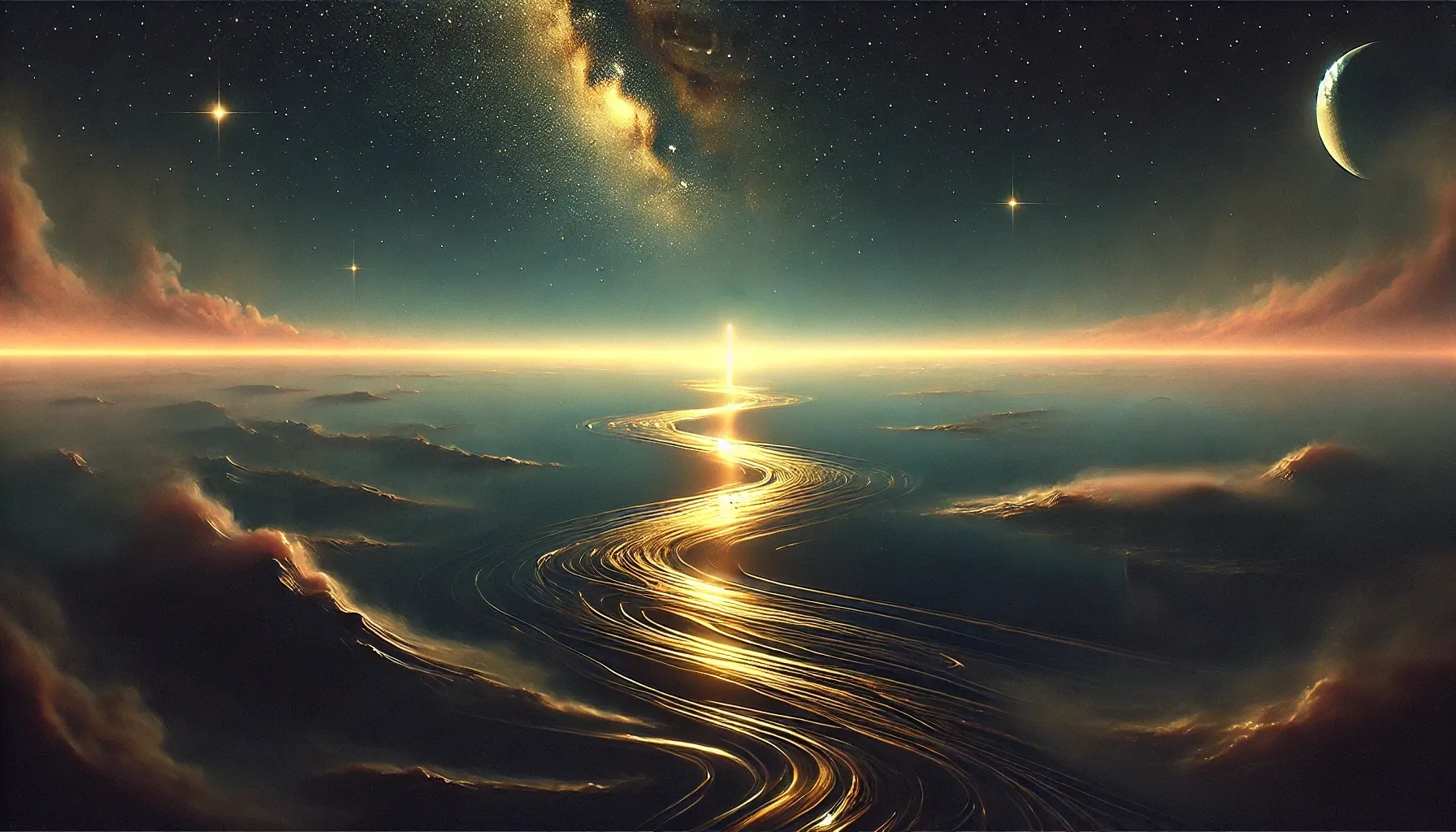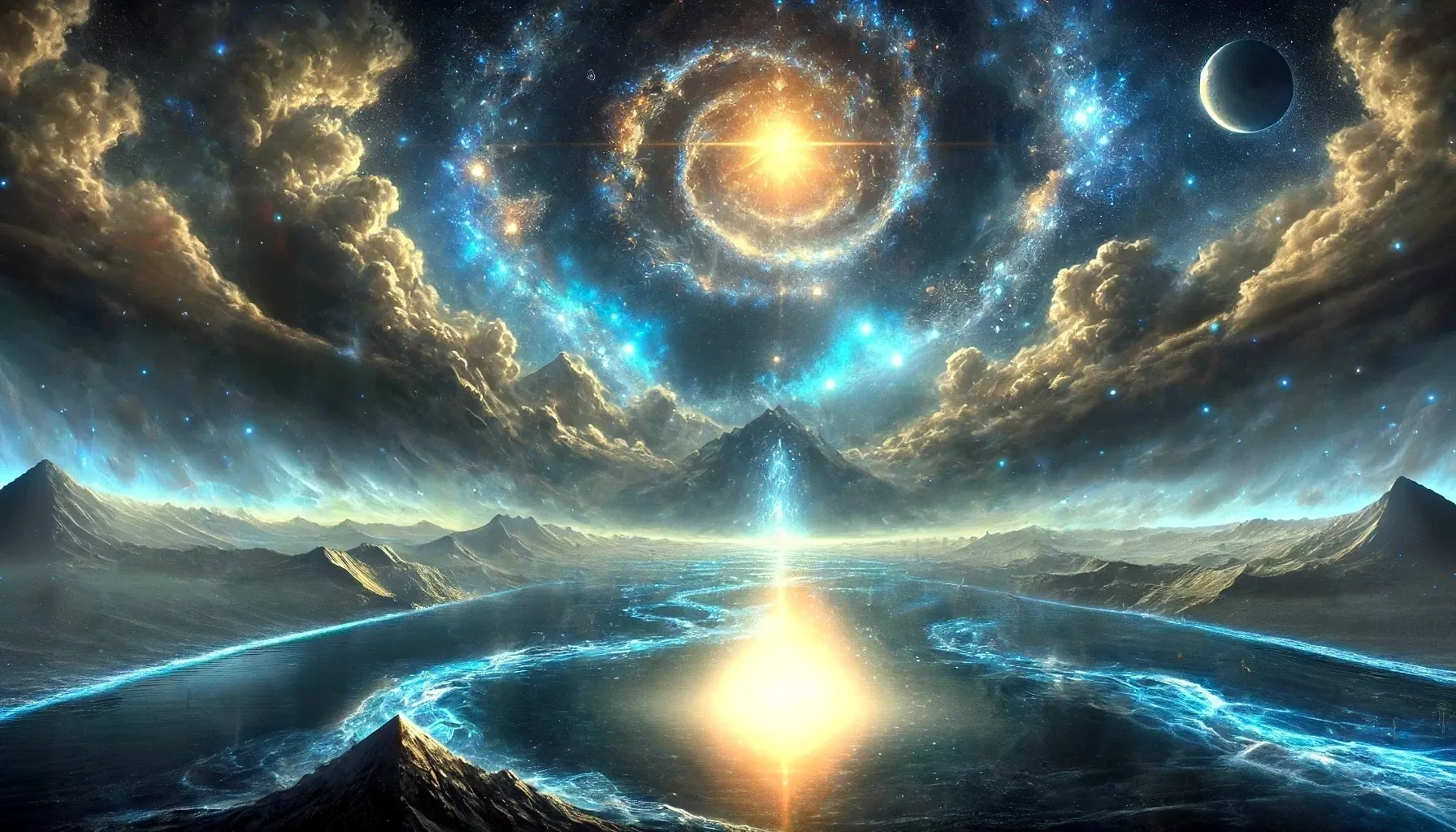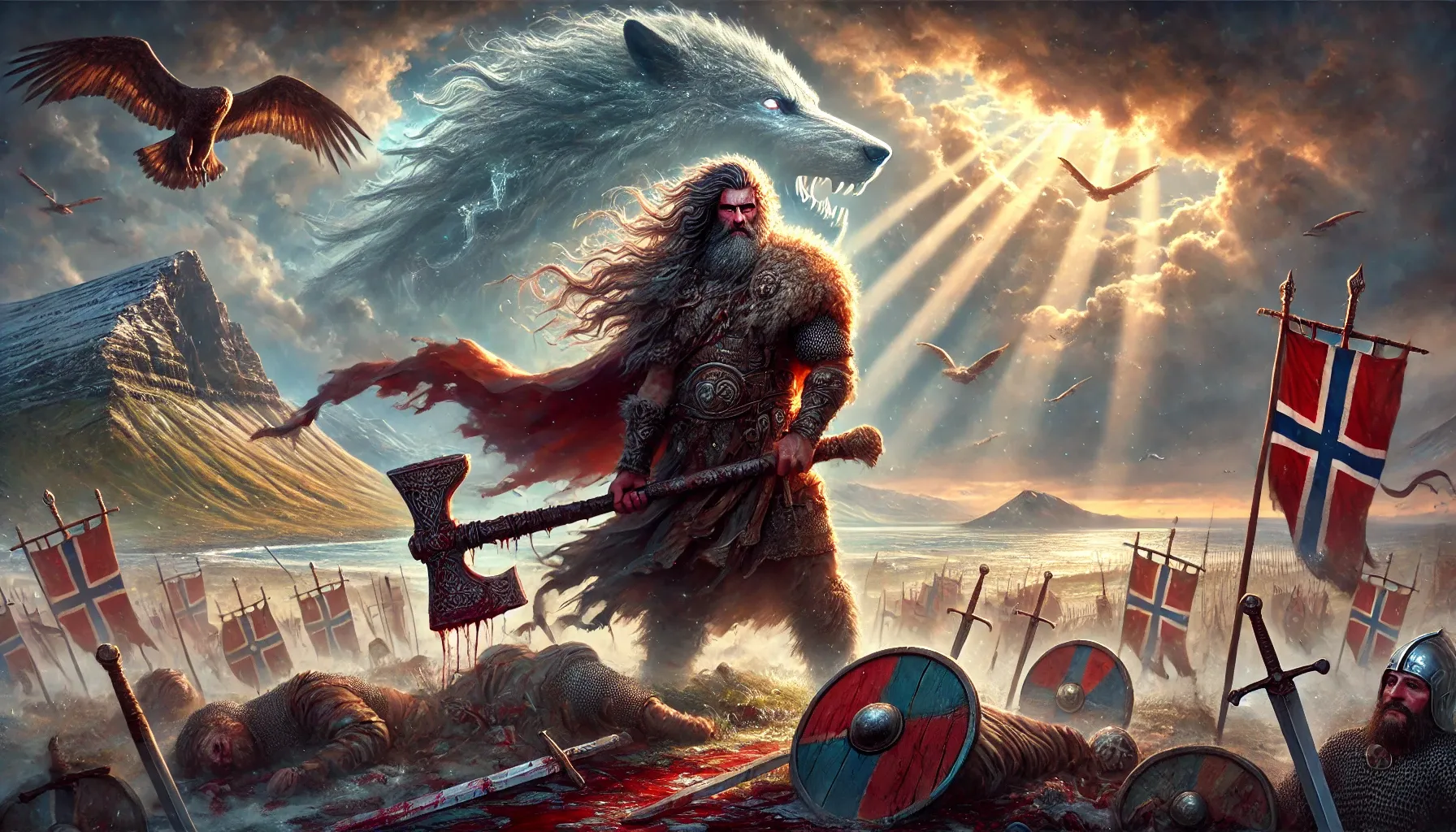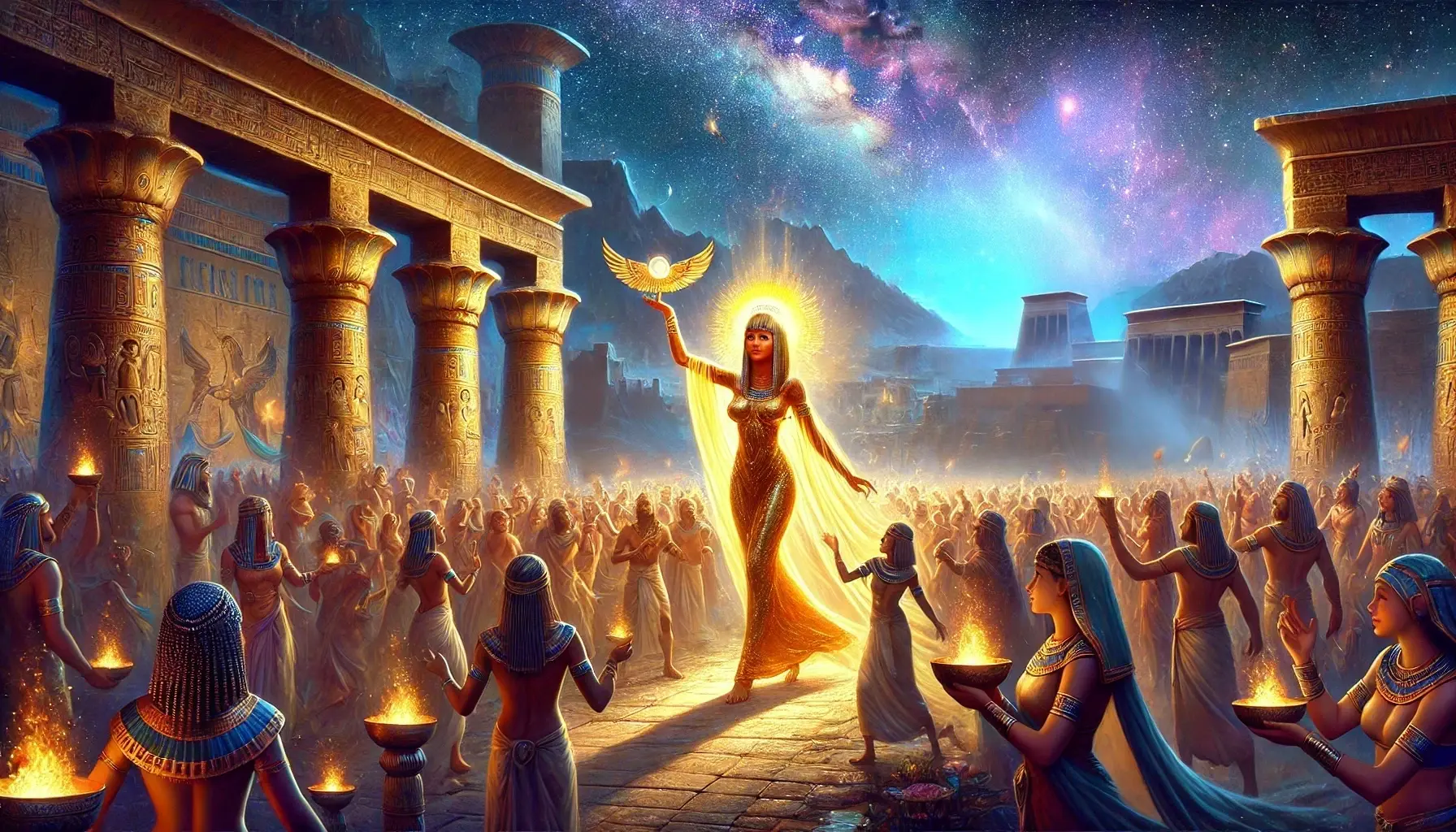The Dawn of the Solar Bark
In the time before time, when the earth was newly molded from chaos and the stars danced untethered, Ra, the Sun God, prepared his celestial voyage. His Solar Bark, known as Mandjet, glimmered like molten gold upon the horizon. Fashioned by the hands of the divine craftsmen, its hull bore the glyphs of creation, and its sails whispered prophecies to the winds. Each dawn, Ra emerged from the horizon’s embrace, his form radiant and eternal, yet burdened with the knowledge that the heavens were not yet subdued.
The world stirred at his arrival. Lotus flowers unfurled their petals, exhaling the breath of life; rivers mirrored his light in shimmering waves; and mortals raised their arms in prayer. Yet Ra was not alone in this journey. A retinue of deities accompanied him: Ma’at, the feather of truth, who steadied the Bark’s course; Heh, who measured eternity with his boundless reach; and the ever-watchful Khepri, whose scarab form rolled the sun into being each morning.
As the Bark lifted from the edge of the earth, the eastern horizon ignited in hues of rose and amber. Each stroke of the oar was a heartbeat of the cosmos, driving Ra into the arc of day. Yet beyond the glory of his ascent, shadows stirred, foretelling the perils to come.
The Ascent Through the Day Sky
By midmorning, the world basked in Ra’s full splendor. From his vantage in the heavens, Ra surveyed the land below. Fields of barley swayed in rhythmic homage, and the Nile’s serpentine form gleamed like the scales of an ancient god. The people prospered under his light, their labors blessed by his unwavering gaze.
But Ra’s journey was far from serene. At every moment, the goddess Nut, who stretched across the heavens, opened her star-filled mouth to consume the solar disk, only to relent when Ra’s light proved unyielding. The divine canopy shimmered with the interplay of dominance and surrender—a cosmic dance as old as creation itself.
Among Ra’s company, Thoth, the ibis-headed keeper of wisdom, recorded the movements of the sun, his quill tracing eternity on scrolls of papyrus. Meanwhile, the protective serpent Mehen coiled itself around the Bark’s hull, its scaled armor a bulwark against the darkness that loomed ahead. Yet Ra himself remained silent, his thoughts a labyrinth of foresight and dread. For even as the sun shone brightest, the inevitability of descent weighed heavy upon him.
The Trials of the Duat
As the sun dipped westward, the day’s certainty gave way to the unknown. Ra and his companions approached the gates of the Duat, the underworld realm through which the Bark must pass before night could yield to dawn. Here, the waters grew dark and stagnant, and the air thickened with the cries of lost souls.
Awaiting them in this realm was Apep, the serpent of chaos, a beast so immense that its coils spanned the breadth of existence. Apep’s very presence unmade the fabric of reality, and its venomous breath extinguished stars. The Bark’s crew braced themselves, for this was no mere journey but a battle for the cosmos itself.
Ra stood at the prow, his staff ablaze with celestial fire. As Apep’s shadow rose to envelop the Bark, Mehen struck first, hurling his coiled form at the serpent. The clash of scales and fangs echoed through the Duat, a sound that rippled into the mortal world as distant thunder. Ma’at balanced the Bark, her feather glowing with truth’s unwavering light, while Thoth chanted spells to bind chaos. Yet the battle was not won by force alone.
Ra turned inward, drawing from the essence of his own light. His fiery orb dimmed momentarily, as if surrendering to the void, before exploding in a burst of golden brilliance. Apep recoiled, its form unraveling into nothingness, though its defeat was never permanent. The serpent of chaos, like all dark forces, would return.
The Bark, battered but intact, sailed onward, guided by the luminescence of Ra’s resolve. The Duat yielded its secrets grudgingly, revealing gateways of obsidian and rivers of starlight. Each passage brought Ra closer to his destination, though the trials left their mark on his divine form.
The Descent into Renewal
As the Bark approached the western horizon, the world above grew hushed. Mortals gazed at the setting sun, their hearts heavy with the knowledge that darkness would soon claim the land. Ra, too, felt the pull of finality, for his light was not infinite.
At the edge of the horizon, Nut bent low, her starry arms cradling the Solar Bark as it prepared to plunge into her embrace. Ra’s form dimmed, his radiance reduced to a glowing ember, yet within him burned the seed of rebirth. The deities aboard the Bark, weary but resolute, prepared for the transition, their roles shifting as the cycle demanded.
Beneath the earth, in the hidden chambers of the Duat, Ra encountered his own reflection—a being both himself and other. This was Atum, the original creator, whose ancient eyes bore the wisdom of uncounted ages. Atum spoke not in words but in visions, showing Ra the endless cycle of creation and destruction. Ra’s heart, heavy with the weight of his journey, grew lighter in the presence of this primordial truth.
As the Bark sailed through the final gate, the first glimmers of dawn painted the eastern horizon. The world above stirred, sensing the return of their god. In a final act of renewal, Ra shed his aged form, allowing Khepri to roll the sun anew. The scarab god pushed the glowing orb into the sky, where it emerged triumphant, reborn from the ashes of the night.
The Eternal Cycle
The sun rose, gilding the world in light once more. Yet this dawn was not merely a repetition; it bore the memory of battles fought and truths revealed. Mortals looked to the sky, their hearts lifted by the promise of another day, though few understood the trials their god endured to bring it forth.
In the heavens, Ra’s new form gleamed with youthful vigor. The Solar Bark glided forward, its journey unbroken, its purpose eternal. Yet beneath the surface of the Duat, Apep stirred, its chaos coiling anew, waiting for the moment to strike. The cycle persisted, a testament to the delicate balance between order and chaos, light and dark.
As Ra’s Bark sailed into the light, a single lotus bloom floated upon the Nile. Its petals quivered in the breeze, catching the sun’s reflection in a golden shimmer. Within its heart, a tiny scarab emerged, pushing against the fragile cocoon of its existence. It unfurled its legs, testing the air, before rolling a speck of light toward the horizon.
And so, the story began again, not with finality but with the infinite promise of rebirth, a cycle woven into the fabric of existence. The sun climbed higher, a beacon of both triumph and inevitability, as the world—and all within it—dared to dream anew.



